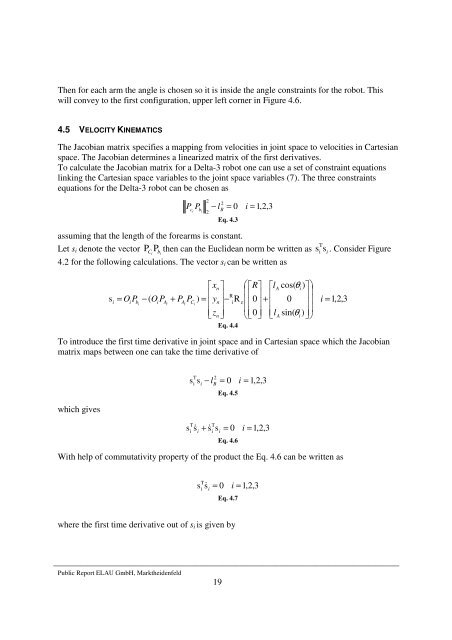Download full document - Automatic Control
Download full document - Automatic Control
Download full document - Automatic Control
You also want an ePaper? Increase the reach of your titles
YUMPU automatically turns print PDFs into web optimized ePapers that Google loves.
Then for each arm the angle is chosen so it is inside the angle constraints for the robot. This<br />
will convey to the first configuration, upper left corner in Figure 4.6.<br />
4.5 VELOCITY KINEMATICS<br />
The Jacobian matrix specifies a mapping from velocities in joint space to velocities in Cartesian<br />
space. The Jacobian determines a linearized matrix of the first derivatives.<br />
To calculate the Jacobian matrix for a Delta-3 robot one can use a set of constraint equations<br />
linking the Cartesian space variables to the joint space variables (7). The three constraints<br />
equations for the Delta-3 robot can be chosen as<br />
2<br />
Pc P i bi<br />
2<br />
B<br />
2<br />
− l = 0 i = 1,<br />
2,<br />
3<br />
Eq. 4.3<br />
assuming that the length of the forearms is constant.<br />
Let si denote the vector PC P i b then can the Euclidean norm be written as s s<br />
i<br />
i<br />
T<br />
i . Consider Figure<br />
4.2 for the following calculations. The vector si can be written as<br />
⎡xn<br />
⎤ ⎛⎡R⎤<br />
⎡lA<br />
cos( θi)<br />
⎤⎞<br />
⎜<br />
⎟<br />
R<br />
= O ( )<br />
⎢ ⎥<br />
i R<br />
⎢<br />
⎜ 0<br />
⎥ ⎢<br />
0<br />
⎥<br />
iPb<br />
− O P + P P =<br />
⎢<br />
y<br />
⎥<br />
−<br />
⎢ ⎥<br />
+<br />
⎢ ⎥⎟<br />
i = 1,<br />
2,<br />
3<br />
i i Ai<br />
Ai<br />
C n<br />
⎢ ⎥ ⎜<br />
0 sin( )<br />
⎟<br />
⎣z<br />
⎦ ⎝<br />
⎢⎣<br />
⎥⎦<br />
⎢⎣<br />
l ⎥<br />
n<br />
A θi<br />
⎦⎠<br />
s z<br />
i i<br />
Eq. 4.4<br />
To introduce the first time derivative in joint space and in Cartesian space which the Jacobian<br />
matrix maps between one can take the time derivative of<br />
which gives<br />
T 2<br />
s s − = 0 i = 1,<br />
2,<br />
3<br />
i<br />
i<br />
l B<br />
Eq. 4.5<br />
T T<br />
s s&<br />
+ s&<br />
s = 0 i = 1,<br />
2,<br />
3<br />
i<br />
i<br />
i<br />
i<br />
Eq. 4.6<br />
With help of commutativity property of the product the Eq. 4.6 can be written as<br />
s T<br />
i i<br />
s&<br />
= 0 i = 1,<br />
2,<br />
3<br />
Eq. 4.7<br />
where the first time derivative out of si is given by<br />
______________________________________________________________________________<br />
Public Report ELAU GmbH, Marktheidenfeld<br />
19














